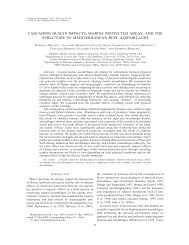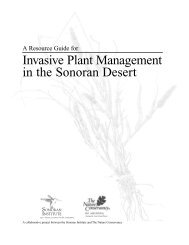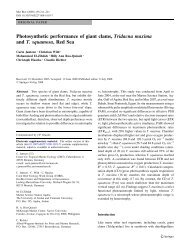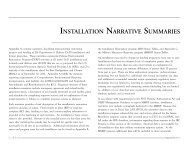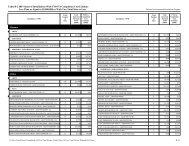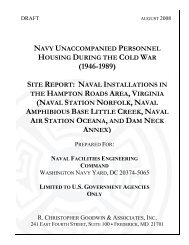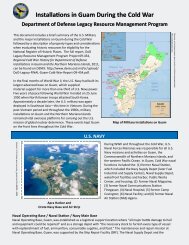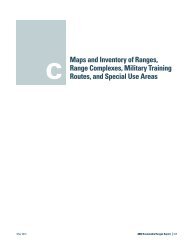Appendix M: Installation Narrative Summaries - denix
Appendix M: Installation Narrative Summaries - denix
Appendix M: Installation Narrative Summaries - denix
You also want an ePaper? Increase the reach of your titles
YUMPU automatically turns print PDFs into web optimized ePapers that Google loves.
‚����˜—��2e���2e���������2€�—�� x€vGf‚eg2PHHS<br />
2ppshX<br />
2ƒ���X<br />
2w������X<br />
2r‚ƒ2ƒ���X<br />
2seq2ƒ�—���X<br />
2g���—���—���X<br />
2w���—2e������X<br />
2p������2��2h—��X<br />
€�������2„�2h—��<br />
In 1942, the Army constructed what is now the Riverbank Army<br />
Ammunition Plant (AAP) as an aluminum reduction plant to<br />
supply military requirements. EPA placed the installation on the<br />
NPL in February 1990. In 2005, the BRAC Commission<br />
recommended Riverbank AAP for closure. Since 1951, the<br />
installation has manufactured brass and steel cartridge cases<br />
for the Army and the Navy. Other manufactured products<br />
include grenades and projectiles, which the Army ships to other<br />
ammunition plants for loading operations. In FY85, a<br />
preliminary assessment and site inspection identified the<br />
following sites: an industrial wastewater treatment plant, an<br />
abandoned landfill, and four evaporation and percolation (E/P)<br />
ponds located north of the plant near the Stanislaus River. The<br />
Army and EPA signed an interagency agreement (IAG) in April<br />
1990. In FY92, the Army extended the Riverbank City water<br />
system and connected service to all residents potentially<br />
affected by chromium contamination. The installation formed a<br />
technical review committee in 1994. In FY97, the Army<br />
submitted a petition to delete the installation from the NPL;<br />
however, EPA determined that NPL deletion was premature<br />
since groundwater cleanup goals had not been met. EPA<br />
approved the preliminary closeout report and the remedial<br />
action completion report. The Army completed 5-year reviews<br />
in FY01 and FY06.<br />
To date, the installation has completed one installationwide<br />
Record of Decision. The cleanup progress at Riverbank AAP<br />
for FY02 through FY05 is detailed below.<br />
In FY02, the Army procured a fluidized bed treatment system<br />
for the treatment of nitrates. With the installation of the fluidized<br />
bed reactor at the groundwater treatment system, the<br />
installation was no longer dependent on the City of Riverbank<br />
discharge agreement for its treated water. The installation<br />
continued to explore in situ treatment of the<br />
chromium-contaminated soil at the source to reduce the overall<br />
cleanup duration. The Army initiated an inventory of closed,<br />
transferred, and transferring (CTT) ranges and sites with<br />
unexploded ordnance, discarded military munitions, or<br />
munitions constituents.<br />
In FY03, the installation continued to work towards<br />
implementing a pilot test for in situ treatment of the<br />
Army<br />
geWPIQVPHUSWHH<br />
IUP2—���<br />
w—���—����2����—���D2����������D2—��2�����2—�������2—�����<br />
TQFWRY2��—��2��2x€v2��2p�˜��—��2IWWH<br />
seq2������2��2e����2IWWH<br />
g�������D2�—����D2���<br />
q������—���2—��2����<br />
62SRFU2�������<br />
2i��F2g„g2@g���2‰�—�AX 62PFV2�������@p‰2PHHWA<br />
2s‚€Gww‚€2ƒ����2p��—�2‚s€G‚gX p‰2IWWVGp‰2PHHU<br />
2p���E‰�—�2‚�����2ƒ�—���X g��������2<br />
chromium-contaminated soil in the source area, including<br />
negotiations with the California Regional Water Quality Control<br />
Board (RWQCB) regarding the need for an additional waste<br />
discharge permit for this pilot test. Work continued on an<br />
evaluation of background groundwater and surface water<br />
conditions at the E/P ponds. The installation shut down the<br />
fluidized bed reactor because it was no longer needed. Work<br />
began on the bench-scale test for cyanide source destruction.<br />
The Army completed the inventory of CTT ranges and sites.<br />
The inventory identified one Military Munitions Response<br />
Program (MMRP) site, a closed small arms range.<br />
In FY04, the installation converted Monitoring Well 109B to an<br />
extraction well and put it into service. Studies of the well's<br />
performance showed that it improved the efficiency of the<br />
groundwater containment system and reduced the amount of<br />
pumping required to provide full capture, resulting in lower<br />
costs. The Army obtained the permit from the RWQCB for the<br />
in situ chromium treatment pilot project and initiated testing in<br />
the primary source area. The Army completed the bench-scale<br />
component of the in situ cyanide destruction pilot test and<br />
initiated discussions with RWQCB regarding regulatory<br />
requirements for implementing a field test. The Army issued a<br />
performance-based contract to accelerate completion of the<br />
groundwater cleanup. Work continued on evaluating<br />
background groundwater and surface water conditions at the<br />
E/P ponds as part of the effort to get a permanent increase in<br />
the allowable nitrate discharge limit.<br />
In FY05, Riverbank AAP was identified for closure as part of<br />
BRAC 2005. Riverbank AAP initiated optimization efforts for the<br />
extraction scenario from off-site wells. The installation<br />
completed the in situ chromium treatment pilot test in the<br />
primary source area. Under the MMRP, the installation awarded<br />
a contract to conduct a historical review and archive search for<br />
the small-arms range.<br />
p‰HT2s‚€2€�������<br />
Riverbank AAP continued to optimize the current groundwater<br />
treatment system and completed the second 5-year review. The<br />
Army initiated groundwater investigative activities necessary for<br />
evaluation of potential treatment alternatives to potentially<br />
expedite cleanup efforts. As part of the environmental<br />
‚����˜—��D2g—�������—<br />
evaluation component of BRAC 2005, the Army completed the<br />
draft final environmental condition of property (ECP) report.<br />
Funding issues delayed the in situ treatment of groundwater.<br />
p‰HT2ww‚€2€�������<br />
The Army conducted a historical records review and archive<br />
search for the small arms range.<br />
€�—�2��2e����<br />
Plan of action items for Riverbank Army Ammunition Plant are<br />
grouped below according to program category.<br />
22222s‚€<br />
0 Initiate in situ treatment pilot studies for<br />
groundwater in FY07.<br />
0 Complete BRAC 2005 ECP and CERFA reports in<br />
FY07-FY08.<br />
0 Complete groundwater investigation activites<br />
and initiate potential treatment alternatives<br />
to expedite cleanup in FY07-FY08.<br />
22222ww‚€<br />
0 Collect soil samples at the MMRP site in<br />
FY07-FY08.<br />
M-175




